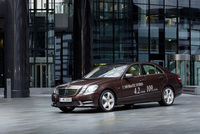The world's most economical luxury-class model

Mercedes-Benz is opening a new chapter in its brand's core segment and at the same time setting new standards for luxury-class business vehicles: the E 300 BlueTEC HYBRID, available as a Saloon and Estate, impresses with new record values when it comes to efficiency. It boasts exemplary consumption levels (67.2 mpg) as well as impressive performance: the 4-cylinder diesel engine of the E 300 BlueTEC HYBRID has 204 hp and 500 Nm. Combined with an electric motor producing 250 Nm, this results in a coherent overall concept. The E 300 BlueTEC HYBRID is the most economical luxury-class vehicle in the world.
The V6 petrol engine in the E 400 HYBRID produces 306 hp and 370 Nm, and is also supplemented by a further 250 Nm from the electric motor. The consumption figures based on the American CAFE standard are: City 24 mpg, Highway 31 mpg, Combined 27 mpg.
"With these two E-Class models we are now continuing our comprehensive hybrid offensive. The modular technology opens up a quick way for us to complement other model series with hybrid models", explains Professor Dr. Thomas Weber, Daimler Board Member for Group Research and Head of Mercedes-Benz Cars Development. "With a clear focus on the different requirements of the global markets, we are able to offer precisely the models which our customers want. The E-Class hybrids provide a clear reduction in consumption as well as a very impressive driving experience: they represent hybrid motoring at the premium level."
The new models do not require their passengers to have to compromise when it comes to space, however, whether in terms of the interior or the luggage compartment. And there are also additional benefits to the intelligent modular hybrid concept, which represents a comprehensive enhancement of the Mercedes-Benz S 400 HYBRID which has advanced to the position of clear market leader since 2009: no changes to the vehicle body are required, the hybrid module is both flexible and modular, thus allowing its use in other model series, and in addition to diesel and petrol variants there will also be right-hand drive variants. Meanwhile, the extra cost involved here is only moderate. The new hybrid models will be celebrating their world premiere at the Detroit Motor Show (14 to 22 January 2012) and will appear on the market over the course of the year. The E 300 BlueTEC HYBRID is initially planned to be launched on the European market, while the E 400 HYBRID will be made available on the American market first, followed by other countries such as Japan and China later.
The philosophy: increase efficiency without compromising comfort or use
The new hybrid models from Mercedes-Benz are part of the company's intelligent downsizing strategy which aims to make conventional models perform significantly more efficiently than ever before – without compromising when it comes to driveability or comfort. As part of this move, rather than focusing primarily on regular consumption, the engineers at the company have been examining exemplary consumption levels in everyday traffic. The notorious safety philosophy known as "Real Life Safety", which similarly highlights gains in safety under practical conditions rather than standard crash test results, is now being paired with "Real Life Efficiency".
Take the E 300 BlueTEC HYBRID by way of example: the hybrid model is based on the notoriously economical E 250 CDI, but exceeds it in terms of performance and undercuts in terms of fuel consumption by around 15 per cent. The details are as follows:
E 250CDI: output of 150 kW, max. torque of 500 Nm, top speed of 242 km/h, acceleration from 0 to 62 mph in 7.5 seconds, consumption of 57.6 mpg, CO2 emissions of 129 g/km
E 350 BlueTEC: output of 155 kW, max. torque of 540 Nm, top speed of 239 km/h, acceleration from 0 to 62 mph in 7.8 seconds, consumption of 41.5 mpg, CO2 emissions of 180 g/km
E 300 BlueTEC HYBRID: output of 150 kW + 20 kW electric motor, max. torque of 500 Nm + 250 Nm, top speed of 242 km/h, acceleration from 0 to 62 mph in 7.5 seconds, consumption of 67.2 mpg, CO2 emissions of 109 g/km (values for Saloon)
As a result, the E 300 BlueTEC HYBRID is on a par with the E 300 CDI (170 kW/540 Nm) in practical use. However, it undercuts this model in terms of consumption and CO2 emissions by around 35 per cent. The E 300 BlueTEC HYBRID also matches the E 300 CDI when it comes to vehicle weight too.
At the same time, hybridisation also represents an increase in ride comfort: starting up and moving off are practically silent, and the hybrid module also dampens any vibrations from the combustion engine. Furthermore, the vehicle's full range of climate control functions remain available even in start/stop mode.

